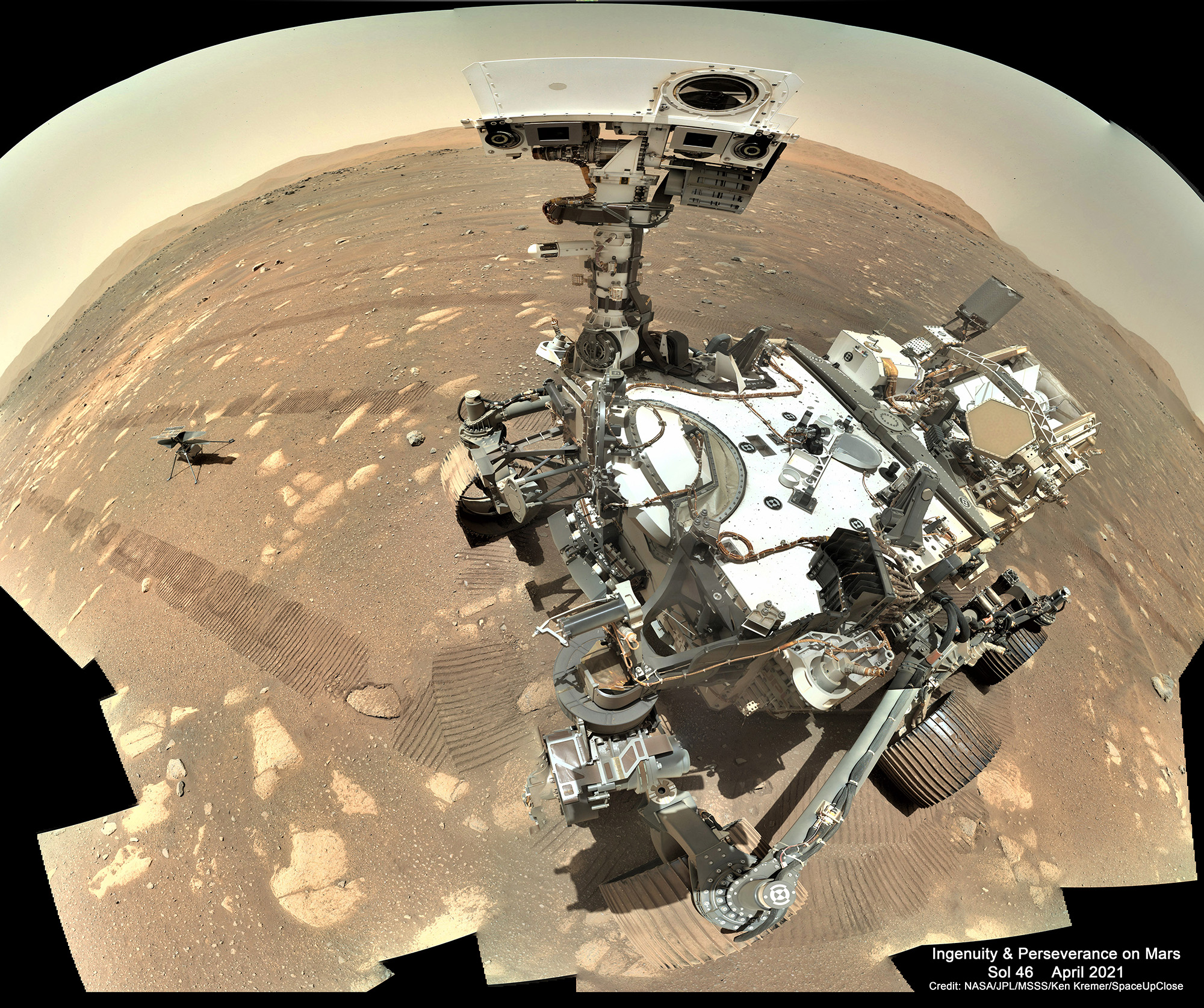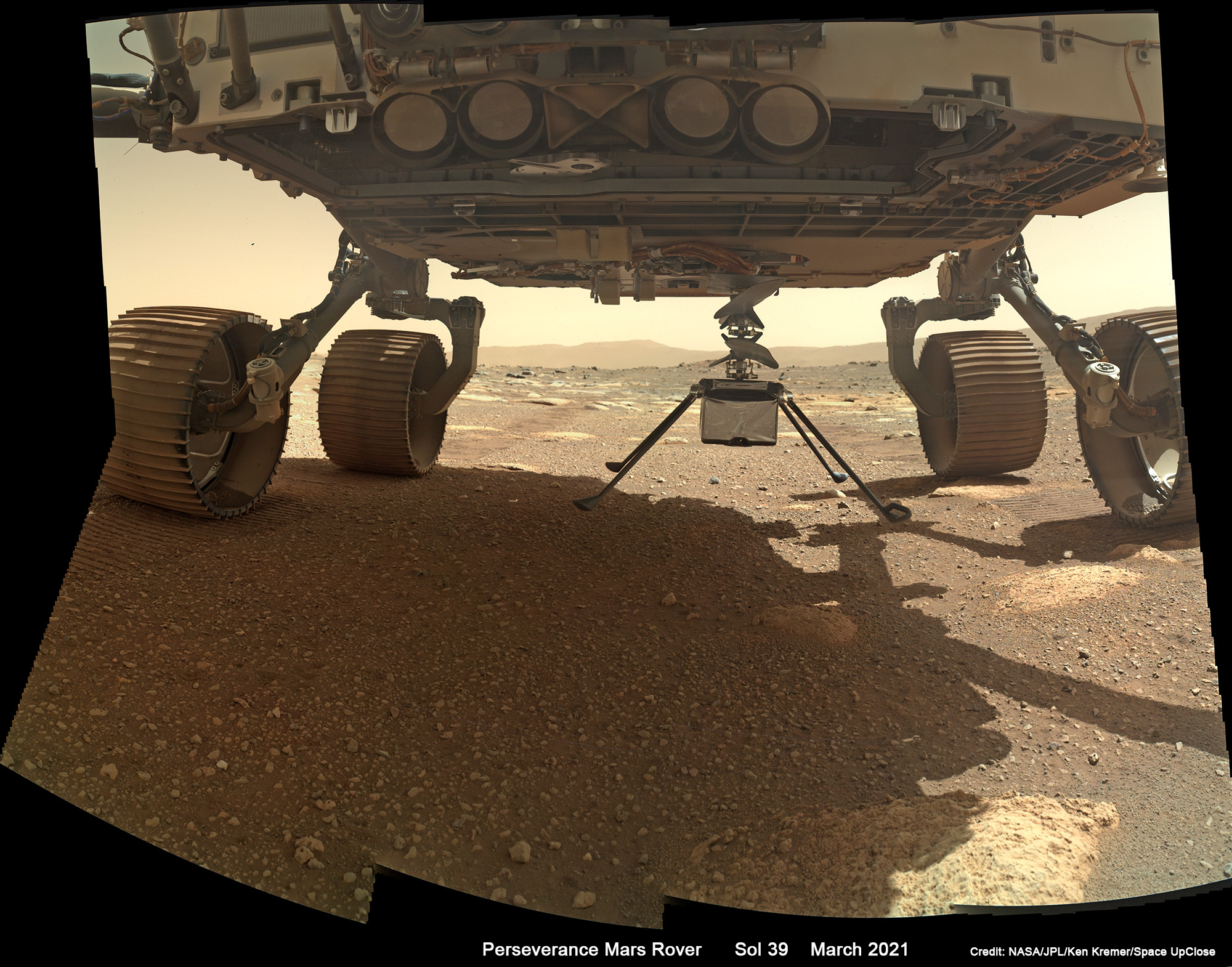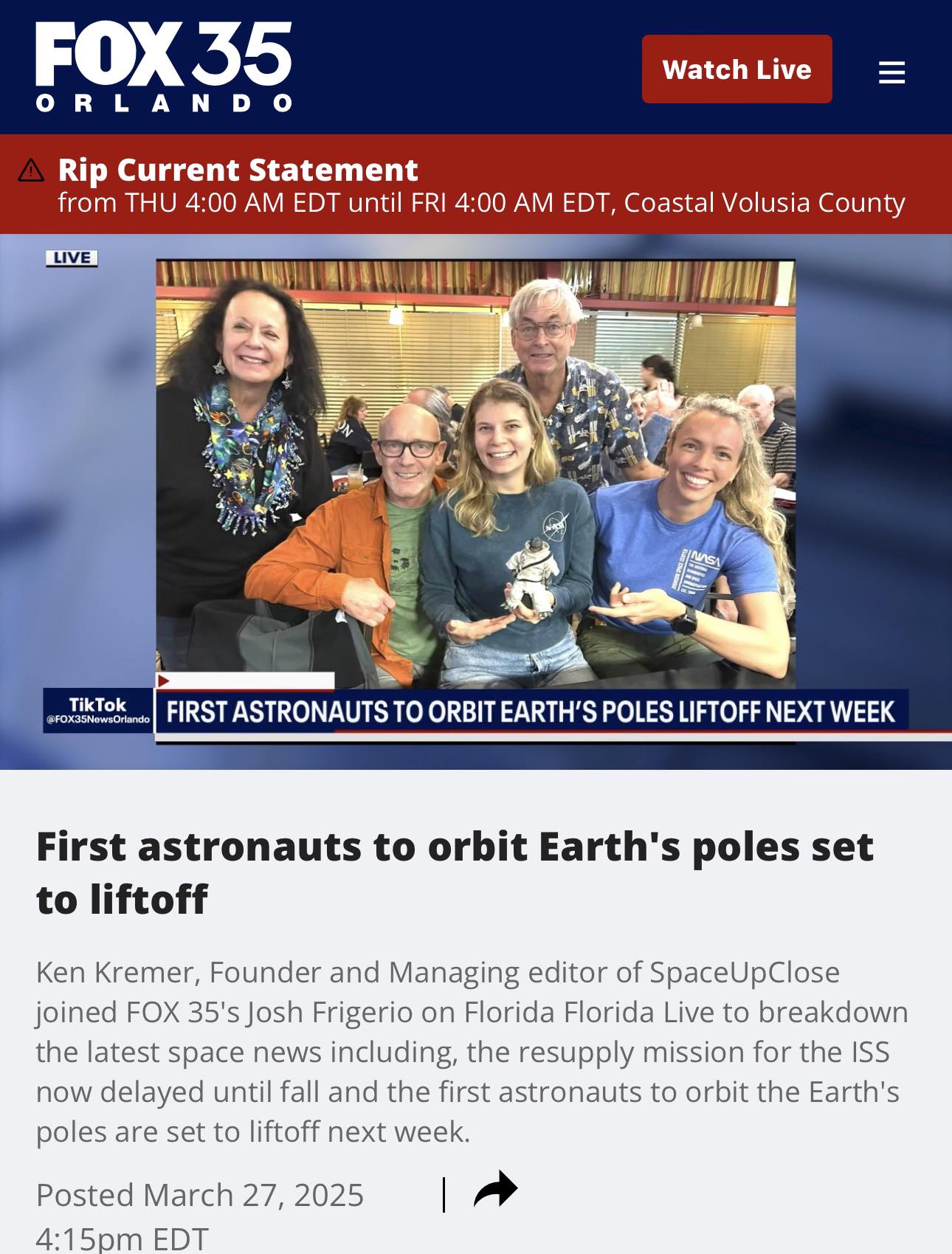
For SpaceUpClose.com & RocketSTEM
CAPE CANAVERAL, FL – NASA’s Ingenuity chopper aced its 3rd test flight on Sunday, April 25, by flying faster, farther and bolder to a half a football field down range and back – thus achieving ever more challenging objectives far beyond anything demonstrated during testing on Earth while making history as humanity’s first aircraft to fly beyond Earth.
It’s simply amazing and virtually serves as a powerful demonstration that helicopters can be used effectively for aerial surveillance on Mars surface and other worlds as well – adding a potent 3rd dimension to exploration activities.
“Today’s flight was what we planned for, and yet it was nothing short of amazing,” said Dave Lavery, the project’s program executive for Ingenuity Mars Helicopter at NASA Headquarters in Washington, in a statement.
“With this flight, we are demonstrating critical capabilities that will enable the addition of an aerial dimension to future Mars missions.”
Ingenuity has now flown leaps and bounds farther vs. what’s available in the vacuum test chamber on Earth.
The Ingenuity helicopter took off at 4:31 a.m. EDT (1:31 a.m. PDT), or 12:33 p.m. local Mars time, rising 16 feet (5 meters) on Sunday – the same altitude as its second flight, the team confirmed.
And it also flew faster – speeding up from 0.5 meters per second in flight #2 to 2 meters per second in flight #3.
“Then it zipped downrange 164 feet (50 meters), just over half the length of a football field, reaching a top speed of 6.6 feet per second (2 meters per second).”
Ingenuity simultaneously also captured several more breathtaking aerial color images of the Red Planet – dramatic background views of the Martian landscape at Jezero Crater and the Perseverance rovers tracks crisscrossing the Red Planet’s ancient surface further demonstrating the paradigm shifting impact of the history making flights of the experimental Martian Chopper.
Far Out 🚁
For this third flight, the #MarsHelicopter traveled almost half the length of a football field and increased its airspeed to 4.5 mph (2 m/sec). Until now, Ingenuity had not flown at this speed, even while testing on Earth. https://t.co/TNCdXWcKWE pic.twitter.com/S65oIeQ4BC— NASA JPL (@NASAJPL) April 25, 2021
Ingenuity also flew longer time for a total of 80 seconds.
The challenges of flying are incredible because the fully autonomous flight is carried out the extremely thin Martian atmosphere with few air molecules amounting to less than 1% as dense as Earth’s– approximately equivalent to 3 times the height of Mount Everest – and under frigid Antarctica-like conditions of minus 90 C (Minus 130 F).
Watch the team jump for joy after the results of the 3rd test flight streamed back to Earth Sunday.
Soaring out of view.🤩
The team was ecstatic to see the #MarsHelicopter report a successful third flight on the Red Planet earlier this morning. They’re digging through a trove of data today and will soon announce plans for a fourth flight. https://t.co/VUKHx2SN2J pic.twitter.com/4BlBiKnLv8— NASA JPL (@NASAJPL) April 25, 2021
The data came back from Mars starting at 10:16 a.m. EDT (7:16 a.m. PDT).
“Ingenuity’s team at NASA’s Jet Propulsion Laboratory in Southern California was ecstatic to see the helicopter soaring out of view,” said NASA.
“They’re already digging through a trove of information gathered during this third flight that will inform not just additional Ingenuity flights but possible Mars rotorcraft in the future.”
Watch this NASA JPL video of the 3rd test flight compiled from imagery captured by the mast mounted zoomable Mastcam-Z camera.
Video Caption: Perseverance Rover’s Mastcam-Z Captures Ingenuity’s successful Third Flight. NASA’s Ingenuity Mars Helicopter takes off and lands in this video captured on April 25, 2021, by Mastcam-Z, an imager aboard NASA’s Perseverance Mars rover. As expected, the helicopter flew out of its field of vision while completing a flight plan that took it 164 feet (50 meters) downrange of the landing spot. Keep watching, the helicopter will return to stick the landing. Top speed for today’s flight was about 2 meters per second, or about 4.5 miles-per-hour. Credit: NASA/JPL-Caltech
The team also commanded Ingenuity to use its two onboard cameras to capture additional black and white look down navigation images and high resolution color images looking out.
The side looking color camera that took the color aerial images is mounted in the helicopter’s tissue box sized fuselage and pointed approximately 22 degrees below the horizon.

Ingenuity’s high-resolution color camera contains a 4208-by-3120-pixel sensor.
Additional imagery was again obtained by the Perseverance rover using its mast mounted Navcam and zoomable Mastcam-Z imagers.

Like the first two flights the third flight was done fully autonomously, based on commands the team sent to Perseverance to relay to Ingenuity the night before.
The flight data from Ingenuity is transmitted back to Perseverance and then relayed back to Earth via NASA’s Mars Reconnaissance Orbiter (MRO) across over 180 million miles of interplanetary space
Two test flights remain – #4 and #5 – during the ‘Month of Ingenuity’ in the 30 Sol long test flight campaign that NASA is giving to the Ingenuity team before the rover must move on to carry out its primary mission.
Flight #4 is expected in a few sols as the chopper team decides how best to expand the envelope and ‘dare mighty things’ to learn the most and glean the most data and insights and find the unknown unknowns for future airborne missions.
‘The little rotorcraft that could’ seems unstoppable in the feats of science and engineering it accomplishes in the ‘Wright Brothers moment’ on Mars and spun up its two counter rotating carbon fiber rotor blades to over 2400 rpm again on Sunday.
Ingenuity’s two counterrotating rotorblades are made of a lightweight carbon fiber foam core to provide lift in the thin Mars atmosphere and measure 4 feet (1.2 meters).
The flight time for the 4-pound (1.8-kg) rotorcraft is chosen to optimize energy and flight conditions and maximize the odds of success.
Perseverance has moved a safe distance away and observes the test flights from about 211 feet (64.3 meters) away at Van Zyl Overlook- see map below.
I’ve taken several turns and made about 0.17 miles (270 meters) of wheel tracks from where I started to my current spot overlooking the #MarsHelicopter.
Check in on my location any time with this interactive map: https://t.co/uPsKFhW17J pic.twitter.com/AO5LJu41f0
— NASA's Perseverance Mars Rover (@NASAPersevere) April 15, 2021
Meanwhile enjoy my version of the Sol 46 double selfie mosaic of Ginny and Percy together

Ginny and Percy (nicknames for Ingenuity and Perseverance) are seen together in my mosaic here about 13 feet (4 meters) apart in imagery taken on April 6, 2021, on Sol 46 of the mission.

The solar powered Ingenuity helicopter is a technology demonstration experiment aimed at attempting the first flight on Mars.
The four legged Ingenuity has a mass of about 4.0 pounds (1.8 kilograms) and stands 1.6 feet or 19 inches (0.49 meters) high.
Watch my live post NASA SpaceX Crew 2 launch interview on The Donlan Report on News Nation Cable News about the significance of the NASA SpaceX Crew 2 launch to ISS launch, Commercial Space, Mars rover/helicopter, the future of space travel and Elon Musk’s plan to build a city on Mars.
https://twitter.com/TheDonlonReport/status/1385993184078176263
Watch my live interview on ‘Stay Curious’ show about NASA SpaceX Crew 2 mission and NASA Ingenuity Helicopter 1st flight – on April 29 at the American Space Museum Titusville, FL
https://www.facebook.com/175507880819/videos/127636489296749
Watch Ken’s continuing reports about Mars 2020 Perseverance and Curiosity rovers, Artemis and NASA missions, SpaceX, Starlink, Commercial Crew and Starliner and Crew Dragon and onsite for live reporting of upcoming and recent SpaceX and ULA launches including Crew 1 & 2, Demo-2, ISS, X-37B, Solar Orbiter, NRO spysats and national security missions and more at the Kennedy Space Center and Cape Canaveral Space Force Station.
Stay tuned here for Ken’s continuing Earth and Planetary science and human spaceflight news: www.kenkremer.com –www.spaceupclose.com – twitter @ken_kremer – email: ken at kenkremer.com
Dr. Kremer is a research scientist and journalist based in the KSC area, active in outreach and interviewed regularly on TV and radio about space topics.
………….
Ken’s photos are for sale and he is available for lectures and outreach events
Ken has created hundreds of widely published Mars rover mosaics and lectures also about NASA’s Mars rovers
Please consider supporting Ken’s work by purchasing his photos and/or donating at Patreon:
https://www.patreon.com/kenkremer


x



